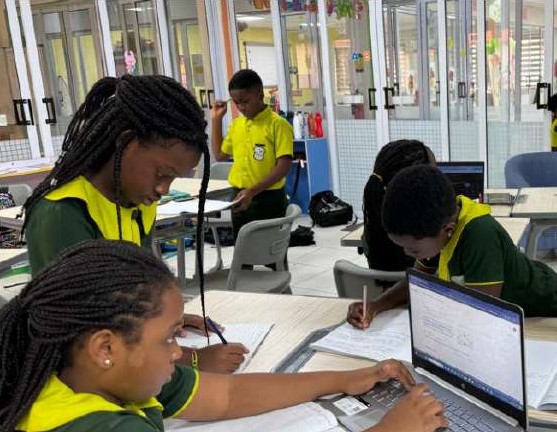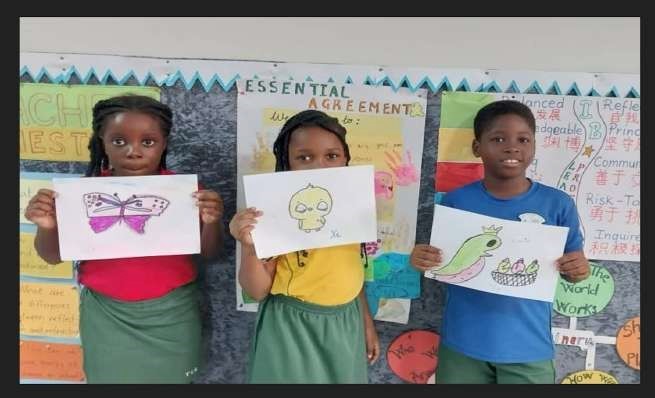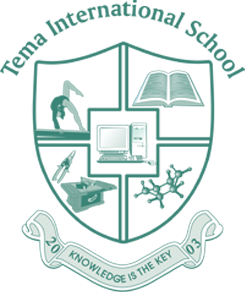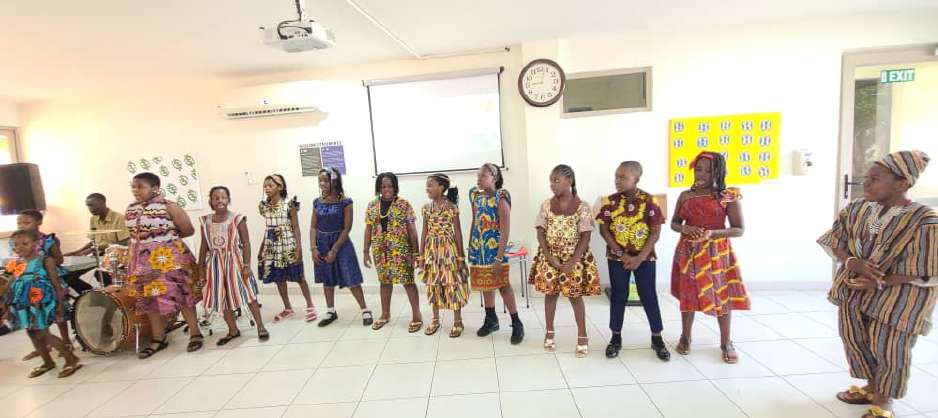Preamble
In the bustling hallways of our school, a world of languages thrives alongside the daily learning and teaching. English, our primary language of instruction, serves as the common ground for communication. However, our curriculum extends beyond English, embracing French, Mandarin, and even sign language as additional avenues of expression. Yet, our commitment to linguistic diversity continues beyond there. We recognise the importance of honouring students’ cultural roots and heritage. That is why languages like Twi, Ewe, Ga, and others find a place in our classrooms, adding colour to our school life and fostering a deeper connection to students’ backgrounds.
At Tema International School Primary Campus, the diversity of languages reflects the global landscape we prepare our students for. Through the International Baccalaureate Primary Years Programme (IB PYP), we recognize that linguistic diversity fosters cultural understanding and open-mindedness. Our commitment to nurturing multilingualism reflects the ethos of the IB, promoting international-mindedness and respect for all cultures. At the Primary School, assemblies are arranged to celebrate languages, giving students opportunities to showcase their linguistic skills and foster an appreciation for diverse languages. Each word spoken, whether in English, French, Mandarin, Sign Language, or mother tongue, is a testament to the value we place on understanding, communication, and the beauty of diversity. Welcome to a place where language is more than just words—it is a bridge that connects us all.
English Language
 As the primary language of instruction at TIS Primary School, the English language has four fundamental strands: Oral language (listening and speaking), visual language (viewing and presenting), reading and writing. Through a transdisciplinary approach, these strands form the foundation of our curriculum, fostering exploration and collaboration across all subjects. At TIS Primary School, our students not only master English language skills but also cultivate essential Approaches to Learning (ATL) skills, such as critical thinking and communication skills, while exploring the language. This empowers them to become effective communicators and critical thinkers and builds curiosity to explore the world through its diverse forms of expression.
As the primary language of instruction at TIS Primary School, the English language has four fundamental strands: Oral language (listening and speaking), visual language (viewing and presenting), reading and writing. Through a transdisciplinary approach, these strands form the foundation of our curriculum, fostering exploration and collaboration across all subjects. At TIS Primary School, our students not only master English language skills but also cultivate essential Approaches to Learning (ATL) skills, such as critical thinking and communication skills, while exploring the language. This empowers them to become effective communicators and critical thinkers and builds curiosity to explore the world through its diverse forms of expression.
Capturing the essence of articulate discourse, students fervently engage in debate. Through thoughtful arguments and impassioned rhetoric, they navigate complex topics with thoughtful arguments, sharpening their communication skills.
Ghanaian Sign Language (GSL)
Learning Ghanaian Sign Language (GSL) at the Primary School is a transformative journey that amplifies students’ voices and fosters a rich culture of multilingualism. By embracing GSL, students embark on a profound exploration of communication, inclusivity, and cultural diversity. GSL provides students with a powerful tool to express themselves authentically. One would be surprised to learn that some students seamlessly transition between verbal communication and Sign Language whenever they choose. This mode of expression empowers them to share their thoughts, ideas, and emotions with clarity and confidence, thus ensuring that their voices are heard and respected.
Moreover, the learning of GSL fosters a deep appreciation for multilingualism at the Primary School. By engaging with GSL alongside other spoken languages, students develop a holistic understanding of communication and language diversity. This broadens their linguistic skills and cultivates a spirit of inclusivity and empathy towards individuals with diverse communication needs. Embracing GSL aligns with the core principles of the IB curriculum, which emphasizes intercultural understanding and global citizenship. Through the study of GSL, students gain insight into the rich cultural heritage of the Ghanaian Deaf community, fostering respect for diverse linguistic and cultural identities. Annually, students organise an event to honour and appreciate deaf individuals worldwide, typically held on 23 September each year. This exposure encourages students to become active participants in a global society, equipped with the knowledge and empathy to navigate the complexities of an interconnected world, fostering empowerment, inclusion, cultural enrichment, and a compassionate learning community. At the Primary School, right from the outset, students are introduced to the fundamentals of GSL and the importance of mastering it. As they progress, they develop a deeper appreciation for the language and enhance their skills accordingly. Additionally, they can interact effectively with members of the deaf community in their surroundings, further enriching their understanding and usage of GSL.
French
French, or “La Langue de Molière”, is widely spoken around the world and is one of the official languages of many international organisations and countries, making it valuable for communication in a global context. Learning French opens up opportunities for cultural enrichment, as students can engage with French literature, art, cuisine, and cinema. It equips students with valuable linguistic and cultural skills that can benefit them personally and professionally.
“Bienvenue” to TIS Primary School, where French is both an enrichment in the early years and an additional language from grades one to six. In the early years, students are introduced to French through fun and interactive activities that foster a love for the language and its culture. As they progress through grades one to six, French becomes a structured part of the curriculum, allowing students to develop their language skills in listening, speaking, reading, and writing. Through immersion in the language and exposure to authentic materials, students at Tema International School gain not only fluency in French but also a deeper appreciation for the diversity of the Francophone world.
Mandarin
Mandarin Chinese is the most spoken language in the world, with over a billion native speakers. As China’s economic and cultural influence grows globally, proficiency in Mandarin opens up opportunities for business, diplomacy, and cultural exchange. Therefore, introducing Mandarin Chinese into TIS primary school curricula offers numerous benefits, both practical and cognitive, it not only equips students with valuable language skills but also prepares them to thrive in an increasingly interconnected and diverse world.
Learning Mandarin provides students with insights into Chinese culture, traditions, and values. This fosters cross-cultural understanding and promotes tolerance and appreciation for diverse perspectives. It involves mastering a tonal language with a unique writing system.
This challenges students’ cognitive abilities and enhances their linguistic skills. Studies have shown that bilingualism or multilingualism can improve cognitive function, including problem-solving, creativity, and multitasking. Proficiency in Mandarin also allows our students to communicate with Mandarin speakers both domestically and internationally. It promotes effective communication and fosters connections with people from different backgrounds. Our students are empowered through the following strands of the language: oral language (listening and speaking), visual language (viewing and presenting), and written language (reading and writing), where we equip them with skills and knowledge that will be increasingly relevant in the future.
MOTHER TONGUE
Ga
 At TIS Primary School, we celebrate different languages, including Ga, through clubs like the Ga Language Enrichment Club. This club helps students learn Ga through fun activities like acting, practicing sounds, and talking in Ga. By learning Ga, students connect more with their culture and better understand others. Plus, knowing Ga can be beneficial for talking with people in our community and learning more about Ghanaian culture. So, at TIS, we think learning different languages is important because it helps us understand each other better and appreciate everyone’s culture.
At TIS Primary School, we celebrate different languages, including Ga, through clubs like the Ga Language Enrichment Club. This club helps students learn Ga through fun activities like acting, practicing sounds, and talking in Ga. By learning Ga, students connect more with their culture and better understand others. Plus, knowing Ga can be beneficial for talking with people in our community and learning more about Ghanaian culture. So, at TIS, we think learning different languages is important because it helps us understand each other better and appreciate everyone’s culture.
Ewe
At the primary school in Tema International School, we cherish and celebrate the beauty of our native Ewe language. It’s not just about learning; it’s about embracing our cultural identity and heritage. Here’s how we make the Ewe language come alive for our students:
Songs and Dance:
Learning should be fun. We incorporate lively songs and traditional dances into our Ewe language lessons. Through these rhythmic experiences, our students learn the language and feel connected to its soulful melodies.
Learning History and Drama:
Understanding where the Ewe language comes from is crucial for appreciating its significance. Our students dive into the captivating history of the Ewe people. They explore their roots and traditions through engaging drama presentations, like the legendary tales of King Agorkorli, which help learners understand the culture behind them.
Dialogue:
Learning a language is most effective when it’s practical. That’s why we teach our students the everyday vocabulary they can use in real-life situations. From greetings and introductions to naming common objects, animals, and fruits, our lessons are relevant and relatable. Our goal is for our students to feel confident using Ewe language in their daily interactions.
In essence, the Ewe language is not just a subject; it’s a celebration of a connection to our community. Through the rhythm of music, the richness of history, and the familiarity of everyday dialogue, our students embark on a journey that enriches their language skills and deepens their cultural understanding. At Tema International School, Ewe language is more than words—it is a celebration of who we are.
Twi
In the diverse tapestry of TIS Primary School, the Twi Enrichment Club is a testament to our commitment to embracing multilingualism. Through activities like role play, phonetics practice, and expression in Twi, students not only connect with their heritage but also sharpen cognitive abilities and cultivate empathy. Multilingualism empowers students to navigate diverse linguistic environments with confidence, making TIS Primary School a beacon of linguistic diversity where every language and culture is valued and celebrated.
Conclusion
Embracing multilingualism at TIS Primary School is essential for fostering cultural understanding, cognitive development, and academic success. By incorporating diverse languages into the curriculum, we can create inclusive learning environments that celebrate linguistic diversity. Prioritising multilingual education at TIS Primary School benefits individual students and contributes to building more interconnected and harmonious societies.







